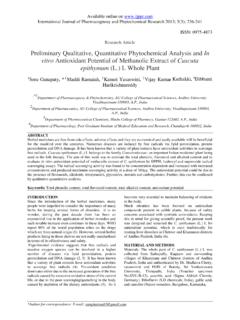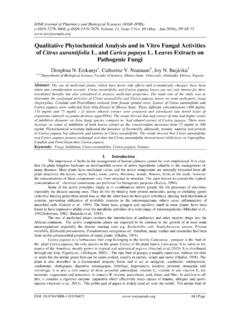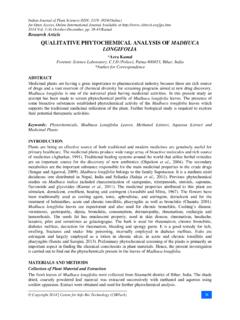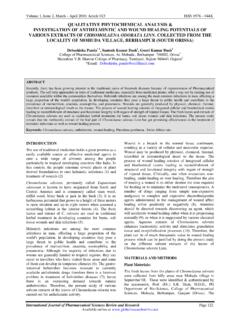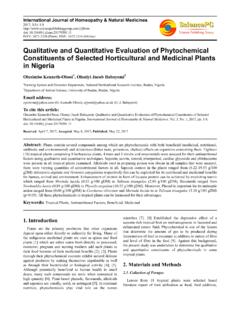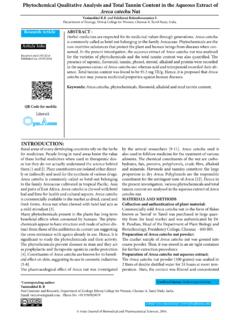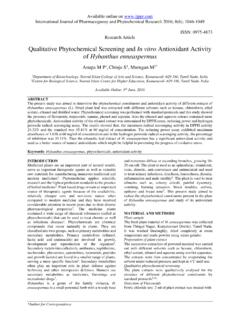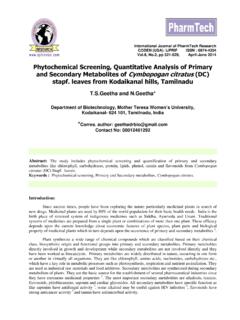Transcription of Phytochemical Analysis of Traditional Medicinal Plants and ...
1 Open Access Journal of Pharmaceutical Research ISSN: 2574-7797 Phytochemical Analysis of Traditional Medicinal Plants and their Antimicrobial Activity: An Experience from North East India J Pharm Res Phytochemical Analysis of Traditional Medicinal Plants and their Antimicrobial Activity: An Experience from North East India Minakshi B, Jharna D, Chanbi Devi E, Nayan T, Partha PK, Kundal N and Manash PS* Department Of Biotechnology, Assam down town University, Panikhaiti, Guwahati, Assam, India *Corresponding author: Manash Pratim Sarma, Department Of Biotechnology, Assam down town University, Panikhaiti, Guwahati, Assam, India, Tel: +91-8255075275; Email.
2 Abstract Introduction: Phytochemicals are non-nutritive, chemical compounds that occur naturally on Plants and have diverse protective properties .Most Phytochemicals like carotenoids, flavonoids and polyphenols have antimicrobial activity and serve as a source of antimicrobial agents against human pathogens. In the present study, five indigenous Plants of Assam namely Oldenlandia corymbosa, Ricinus communis, Lpomea aquatica, Xanthium strumarium, Mentha piperita were analyzed for various Phytochemicals present and their antimicrobial activity. Methods: Phytochemical screening tests was conducted for five plant species and found that extract contains a variety of Phytochemicals like saponins, tannins, flavonoids, terpenoids, glycosides and reducing sugars and among which there is higher level of precipitation for phenol and flavonoids.
3 As they are essential source of antimicrobial agents against pathogens, their extract were tested for its antimicrobial activity by well diffusion method using Nutrient agar against human pathogenic bacteria like Staphylococcus aureus, Escherichia coli. Results: The study plant extract of Xanthium strumarium(leaves, roots) and Mentha piperita(stem) had shown a strong antimicrobial activity against Staphylococcus aureus and the plant extract of Ricinus communis(leaves ,stem, roots), Lpomea aquatica (stem)had shown antimicrobial activity against Escherichia coli. Oldenlandia corymbosa hadn t shown antimicrobial activity for both Staphylococcus aureus and Escherichia coli. This study provided evidence to confirm the presence of various medicinally important bioactive compounds or Phytochemicals that has got biological importance and it justifies their use in the Traditional medicines for the treatment of different diseases and this findings suggest that the selected plant extracts possesses antimicrobial properties that could be used for biological control of bacterial cultures and this bioactive compounds serve as a source of antimicrobial agents against human pathogens.
4 Keywords: Oldenlandia Corymbosa; Ricinus Communis; Lpomea Aquatica; Xanthium Strumarium; Mentha Piperita; Antimicrobial Activity; Phytochemicals Research Article Volume 1 Issue 1 Received Date: August 01, 2016 Published Date: December 14, 2016 Open Access Journal of Pharmaceutical Research Manash PS, et al. Phytochemical Analysis of Traditional Medicinal Plants and their Antimicrobial Activity: An Experience from North East India. J Pharm Res 2016, 1(1): 000104. Copyright Manash PS, et al. 2 Introduction North-eastern India is known for its rich biodiversity. Phytochemical are non-nutritive, chemical compounds occurs naturally on Plants during metabolic processes and they have diverse proactive properties or disease preventive properties. Plants are known to produce these chemicals to protect them.
5 While recent research demonstrates that they can also play an important role in protecting humans against diseases. Even some of these Plants are in use as Traditional medicine for centuries now. Most Phytochemical like flavonoid, carotenoids and polyphones have anti microbial activity and serve as a source of antimicrobial agents against pathogens. The current study was focused on the following plant species Oldenlandia corymbosa, Ricinus communis, Lpomea aquatica, Xanthium strumarium, Mentha piperita. A concise detail about the study Plants is provided below. Details of the studied Plants A. Oldenlandia corymbosa (Diamond flower): A flowering Plants of the genus and family Rubiaceae. It is pantropical in its distribution and has almost 240 species. Oldenlandia corymbosa (Figure 1A) is one of the plant studied in the current research work.
6 B. Ricinus communis (Castor oil plant): The castor oil plant (Ricinus communis) is a species of flowering plant that belongs to spurge family, Euphorbiaceae. Its seed is the castor bean. Castor is indigenous to the southeastern Mediterranean Basin, Eastern Africa, and India and is widespread throughout tropical region (Figure 1B). C. Lpomea aquatica: Lpomoea aquatica is semi aquatic, tropical plant which grows as a vegetable for its tender shoots and leaves. It is found throughout the tropical and subtropical regions of the world, although it is not known where it originated. This plant is known in English as water spinach, river spinach (Figure 1C). D. Xanthium strumarium: Xanthium strumarium (large, cocklebur, woolgarie bur) is a species of annual Plants belonging to the Asteraceae family. It has been extensively naturalized elsewhere (Figure 1D).
7 E. Mentha piperita (Peppermint): Peppermint is a hybrid mint. The plant, indigenous to Europe and the Middle East and is widespread in cultivation in many regions of the world, it is also found wild occasionally with its parent species (Figure 1E). Figure 1: A. Oldenlandia corymbosa; B. Ricinus communis; C. Lpomea aquatic; D. Xanthium strumarium; E. Mentha piperita. In Indian system a large number of Medicinal Plants have been used for many centuries for treating various diseases. Medicinal Plants have been as remedies for human diseases because of its chemical contents of therapeutic value. Most Traditional medicines are developed from nature. Thus Plants remain a major source of Medicinal compounds. As of record around 20,000 plant species are in use for Medicinal purposes across the globe and around 70 % of them are from Indian subcontinent.
8 Considering the Traditional use of the five selected Medicinal Plants species namely Oldenlandia corymbosa, Ricinus communis, Lpomea aquatica, Open Access Journal of Pharmaceutical Research Manash PS, et al. Phytochemical Analysis of Traditional Medicinal Plants and their Antimicrobial Activity: An Experience from North East India. J Pharm Res 2016, 1(1): 000104. Copyright Manash PS, et al. 3 Xanthium strumarium, Mentha piperita as medicines or as a natural remedy for curing several diseases, the present study was initiated with following objectives- A. To investigate various Phytochemical present in the selected Plants particularly the phenolic and flavonoids contents. B. To compare the Phytochemical present in these Medicinal Plants . C. To look for the antimicrobial activity of various parts of the selected Plants .
9 Materials and Methodology Place of work The experiments pertaining to the study were carried out in the Department of Biotechnology, Assam down Town University, Panikhaiti, Guwahati, Assam, India. Collection of plant materials For the present study five native Plants of north east India with known Medicinal property were collected from different locations of NE India. The plant materials were washed under running water, cut into pieces; air dried and pulverized into fine powder in a mortar pestle, the powder was kept in small plastic bags with paper labeling. Preparation of plant extracts Water extract: The water extraction was carried out using classical method where grinded leaves material of 3 gm weighed using an electronic balance and was crushed in 100 ml of sterile water. Then the mixture was boiled at 50-60 C for 30 minutes on water bath and it was filtered through Whitman filter paper.
10 Then filtrate was centrifuged at 2500 rpm for 15 minutes and filtrate was stored in sterile bottles at 5 C for further use. Ethanol extract: Ground samples (3 gm) were extracted with 100 ml of 95% ethanol on water bath at 70 C for 2 hr. The extracted samples were centrifuged and the supernatant was transferred into 50 ml volumetric flask. The volume adjusted to 50 ml with 95% ethanol and the samples were stored at -4 C until Analysis . All water and ethanol extracts were filtered before Analysis . Phytochemical Screening Tests: Preliminary qualitative Phytochemical screening were carried out for steroids (Salkowski test) , terpenoids (Salkowski test), alkaloid (Wagner s Test), flavonoids (Alkaline reagent test, H2SO4 test and Lead acetate test), Tannins (Lead acetate test and Braymer s test), Saponins (Forthing test), Glycosides ( Keller-Kiliani test), Coumains (NaOH test), carbohydrates ( Molisch s , Benedict s test and Fehling s Test), proteins and amino acids ( Xanthoproteic test and Ninhydrin test) following the standard protocols.


